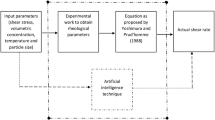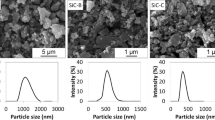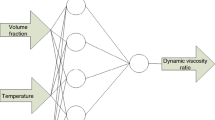Abstract
Prediction models for the viscosity curve of a shear thickening fluid (STF) over a wide range of shear rate at different temperatures were developed using phenomenological and artificial neural network (ANN) models. STF containing 65% (w/w) silica nanoparticles was prepared using polyethylene glycol (PEG) as dispersion medium, and tested for rheological behavior at different temperatures. The experimental data set was divided into training data and testing data for the model development and validation, respectively. For both the models, the viscosity of STF was estimated for all the zones with good fit between experimental and predicted viscosity, for both training and testing data sets.
Similar content being viewed by others
References
Al-Zahrani, S.M., 1997, A generalized rheological model for shear thinning fluids, J. Pet. Sci. Eng. 17, 211–215.
Al-Zahrani, S.M. and T.F. Al-Fariss, 1998, A general model for the viscosity of waxy oils, Chem. Eng. Process. 37, 433–437.
Barnes, H.A., 1989, Shear-thickening (“Dilatancy”) in suspensions of nonaggregating solid particles dispersed in Newtonian liquids, J. Rheol. 33, 329–366.
Bender, J. and N.J. Wagner, 1996, Reversible shear thickening in monodisperse and bidisperse colloidal dispersions, J. Rheol. 40, 899–916.
Bender, J.W. and N.J. Wagner, 1995, Optical measurement of the contributions of colloidal forces to the rheology of concentrated suspensions, J. Colloid Interface Sci. 172, 171–184.
Bird, R.B., W.E. Steward, and E.W. Lightfoot, 1960, Transport Phenomena, 1st ed., Wiley, New York.
Boersma, W.H., J. Laven, and H.N. Stein, 1992, Viscoelastic properties of concentrated shear-thickening dispersions, J. Colloid Interface Sci. 149, 10–22.
Brown, E. and H.M. Jaeger, 2011, Through thick and thin, Science 333, 1230–1231.
Brown, E. and H.M. Jaeger, 2014, Shear thickening in concentrated suspensions: Phenomenology, mechanisms and relations to jamming, Rep. Prog. Phys. 77, 046602.
David, J., P. Filip, and A.A. Kharlamov, 2013, Empirical modelling of nonmonotonous behaviour of shear viscosity, Adv. Mater. Sci. Eng. 2013, 658187.
Esfe, M.H., S. Saedodin, N. Sina, M. Afrand, and S. Rostami, 2015, Designing an artificial neural network to predict thermal conductivity and dynamic viscosity of ferromagnetic nanofluid, Int. Commun. Heat Mass Transf. 68, 50–57.
Galindo-Rosales, F.J., 2016, Complex fluids in energy dissipating systems, Appl. Sci.-Basel 6, 206.
Galindo-Rosales, F.J., F.J. Rubio-Hernández, and A. Sevilla, 2011a, An apparent viscosity function for shear thickening fluids, J. Non-Newton. Fluid Mech. 166, 321–325.
Galindo-Rosales, F.J., F.J. Rubio-Hernández, A. Sevilla, and R.H. Ewoldt, 2011b, How Dr. Malcom M. Cross may have tackled the development of “An apparent viscosity function for shear thickening fluids”, J. Non-Newton. Fluid Mech. 166, 1421–1424.
Galindo-Rosales, F.J., S. Martínez-Aranda, and L. Campo-Deaño, 2015, CorkSTFµfluidics -A novel concept for the development of eco-friendly light-weight energy absorbing composites, Mater. Des. 82, 326–334.
Gürgen, S. and M.C. Kushan, 2017, The stab resistance of fabrics impregnated with shear thickening fluids including various particle size of additives, Compos. Pt. A-Appl. Sci. Manuf. 94, 50–60.
Gürgen, S., M.C. Kushan, and W. Li, 2016a, The effect of carbide particle additives on rheology of shear thickening fluids, Korea-Aust. Rheol. J. 28, 121–128.
Gürgen, S., W. Li, and M.C. Kushan, 2016b, The rheology of shear thickening fluids with various ceramic particle additives, Mater. Des. 104, 312–319.
Hasanzadeh, M. and V. Mottaghitalab, 2014, The role of shearthickening fluids (STFs) in ballistic and stab-resistance improvement of flexible armor, J. Mater. Eng. Perform. 23, 1182–1196.
Head, D.A., A. Ajdari, and M.E. Cates, 2001, Jamming, hysteresis, and oscillation in scalar models for shear thickening, Phys. Rev. E 64, 061509.
Heidari, E., M.A. Sobati, and S. Movahedirad, 2016, Accurate prediction of nanofluid viscosity using a multilayer perceptron artificial neural network (MLP-ANN), Chemometrics Intell. Lab. Syst. 155, 73–85.
Hoffman, R.L., 1998, Explanations for the cause of shear thickening in concentrated colloidal suspensions, J. Rheol. 42, 111–123.
Jiang, B., D.J. Keffer, B.J. Edwards, and J.N. Allred, 2003, Modeling shear thickening in dilute polymer solutions: Temperature, concentration, and molecular weight dependencies, J. Appl. Polym. Sci. 90, 2997–3011.
Kang, T.J., K.H. Hong, and M.R. Yoo, 2010, Preparation and properties of fumed silica/kevlar composite fabrics for application of stab resistant material, Fiber. Polym. 11, 719–724.
Khandavalli, S., J.A. Lee, M. Pasquali, and J.P. Rothstein, 2015, The effect of shear-thickening on liquid transfer from an idealized gravure cell, J. Non-Newton. Fluid Mech. 221, 55–65.
Laun, H.M., R. Bung, S. Hess, W. Loose, O. Hess, K. Hahn, E. Hädicke, R. Hingmann, F. Schmidt, and P. Lindner, 1992, Rheological and small angle neutron scattering investigation of shear-induced particle structures of concentrated polymer dispersions submitted to plane Poiseuille and Couette flow, J. Rheol. 36, 743–787.
Lee, Y.S., E.D. Wetzel, and N.J. Wagner, 2003, The ballistic impact characteristics of Kevlar® woven fabrics impregnated with a colloidal shear thickening fluid, J. Mater. Sci. 38, 2825–2833.
Lee, Y.S., E.D. Wetzel, R.G. Egres, and N.J. Wagner, 2002, Advanced body armor utilizing shear thickening fluids, 23rd Army Science Conference, Orlando, Florida.
Li, H. and J. Zhang, 2003, A generalized model for predicting non-Newtonian viscosity of waxy crudes as a function of temperature and precipitated wax, Fuel 82, 1387–1397.
Liu, X.Q., R.Y. Bao, X.J. Wu, W. Yang, B.H. Xie, and M.B. Yang, 2015, Temperature induced gelation transition of a fumed silica/PEG shear thickening fluid, RSC Adv. 5, 18367–18374.
Macosko, C.W., 1994, Rheology: Principles, Measurements, and Applications, Wiley-VCH, New York.
Majumdar, A., 2011, Soft computing in fibrous materials engineering, Text. Prog. 43, 1–95.
Maranzano, B.J. and N.J. Wagner, 2002, Flow-small angle neu-tron scattering measurements of colloidal dispersion microstructure evolution through the shear thickening transition, J. Chem. Phys. 117, 10291–10302.
Meyer, J.P., S.A. Adio, M. Sharifpur, and P.N. Nwosu, 2016, The viscosity of nanofluids: A Review of the theoretical, empirical, and numerical models, Heat Transf. Eng. 37, 387–421.
Perlácová, T. and V. Pruša, 2015, Tensorial implicit constitutive relations in mechanics of incompressible non-Newtonian fluids, J. Non-Newton. Fluid Mech. 216, 13–21.
Raghavan, S.R., J. Hou, G.L. Baker, and S.A. Khan, 2000, Colloidal interactions between particles with tethered nonpolar chains dispersed in polar media: Direct correlation between dynamic rheology and interaction parameters, Langmuir 16, 1066–1077.
Raghavan, S.R. and S.A. Khan, 1995, Shear-induced microstructural changes in flocculated suspensions of fumed silica, J. Rheol. 39, 1311–1325.
Ramzi, M., M. Kashaninejad, F. Salehi, A.R.S. Mahoonak, and S.M.A. Razavi, 2015, Modeling of rheological behavior of honey using genetic algorithm-artificial neural network and adaptive neuro-fuzzy inference system, Food Biosci. 9, 60–67.
Salehi, F. and S.M.A. Razavi, 2012, Dynamic modeling of flux and total hydraulic resistance in nanofiltration treatment of regeneration waste brine using artificial neural networks, Desalin. Water Treat. 41, 95–104.
Skelland, A.H.P., 1967, Non-Newtonian Flow and Heat Transfer, Wiley, New York.
Srivastava, A., A. Majumdar, and B.S. Butola, 2011, Improving the impact resistance performance of Kevlar fabrics using silica based shear thickening fluid, Mater. Sci. Eng. A-Struct. Mater. Prop. Microstruct. Process. 529, 224–229.
Srivastava, A., A. Majumdar, and B.S. Butola, 2012, Improving the impact resistance of textile structures by using shear thickening fluids: A review, Crit. Rev. Solid State Mat. Sci. 37, 115–129.
Tian, T., G. Peng, W. Li, J. Ding, and M. Nakano, 2015, Experimental and modelling study of the effect of temperature on shear thickening fluids, Korea-Aust. Rheol. J. 27, 17–24.
Zhang, X.Z., W.H. Li, and X.L. Gong, 2008, The rheology of shear thickening fluid (STF) and the dynamic performance of an STF-filled damper, Smart Mater. Struct. 17, 035027.
Zhao, N., X. Wen, J. Yang, S. Li, and Z. Wang, 2015, Modeling and prediction of viscosity of water-based nanofluids by radial basis function neural networks, Powder Technol. 281, 173–183.
Zielinska, D., B. Delczyk-Olejniczak, L. Wierzbicki, B. Wilbik-Halgas, M.H. Struszczyk, and M. Leonowicz, 2014, Investigation of the effect of para-aramid fabric impregnation with shear thickening fluid on quasi-static stab resistance, Text. Res. J. 84, 1569–1577.
Author information
Authors and Affiliations
Corresponding author
Rights and permissions
About this article
Cite this article
Arora, S., Laha, A., Majumdar, A. et al. Prediction of rheology of shear thickening fluids using phenomenological and artificial neural network models. Korea-Aust. Rheol. J. 29, 185–193 (2017). https://doi.org/10.1007/s13367-017-0019-x
Received:
Revised:
Accepted:
Published:
Issue Date:
DOI: https://doi.org/10.1007/s13367-017-0019-x




